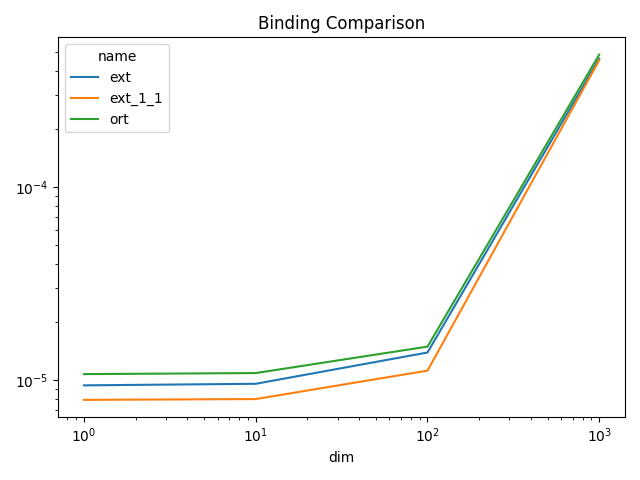Note
Go to the end to download the full example code.
Measuring onnxruntime performance against a cython binding¶
The following code measures the performance of the python bindings against a cython binding. The time spent in it is not significant when the computation is huge but it may be for small matrices.
import numpy
from pandas import DataFrame
import matplotlib.pyplot as plt
from tqdm import tqdm
from onnx import numpy_helper, TensorProto
from onnx.helper import (
make_model,
make_node,
make_graph,
make_tensor_value_info,
make_opsetid,
)
from onnx.checker import check_model
from onnxruntime import InferenceSession
from onnx_extended.ortcy.wrap.ortinf import OrtSession
from onnx_extended.args import get_parsed_args
from onnx_extended.ext_test_case import measure_time, unit_test_going
script_args = get_parsed_args(
"plot_bench_cypy_ort",
description=__doc__,
dims=(
"1,10" if unit_test_going() else "1,10,100,1000",
"square matrix dimensions to try, comma separated values",
),
expose="repeat,number",
)
A simple onnx model¶
A = numpy_helper.from_array(numpy.array([1], dtype=numpy.float32), name="A")
X = make_tensor_value_info("X", TensorProto.FLOAT, [None, None])
Y = make_tensor_value_info("Y", TensorProto.FLOAT, [None, None])
node1 = make_node("Add", ["X", "A"], ["Y"])
graph = make_graph([node1], "+1", [X], [Y], [A])
onnx_model = make_model(graph, opset_imports=[make_opsetid("", 18)], ir_version=8)
check_model(onnx_model)
Two python bindings on CPU¶
sess_ort = InferenceSession(
onnx_model.SerializeToString(), providers=["CPUExecutionProvider"]
)
sess_ext = OrtSession(onnx_model.SerializeToString())
x = numpy.random.randn(10, 10).astype(numpy.float32)
y = x + 1
y_ort = sess_ort.run(None, {"X": x})[0]
y_ext = sess_ext.run([x])[0]
d_ort = numpy.abs(y_ort - y).sum()
d_ext = numpy.abs(y_ext - y).sum()
print(f"Discrepancies: d_ort={d_ort}, d_ext={d_ext}")
Discrepancies: d_ort=0.0, d_ext=0.0
Time measurement¶
run_1_1 is a specific implementation when there is only 1 input and output.
t_ort = measure_time(lambda: sess_ort.run(None, {"X": x})[0], number=200, repeat=100)
print(f"t_ort={t_ort}")
t_ext = measure_time(lambda: sess_ext.run([x])[0], number=200, repeat=100)
print(f"t_ext={t_ext}")
t_ext2 = measure_time(lambda: sess_ext.run_1_1(x), number=200, repeat=100)
print(f"t_ext2={t_ext2}")
t_ort={'average': np.float64(1.4214167399404685e-05), 'deviation': np.float64(9.921318194458582e-06), 'min_exec': np.float64(8.368075032194611e-06), 'max_exec': np.float64(5.840254500071751e-05), 'repeat': 100, 'number': 200, 'ttime': np.float64(0.0014214167399404685), 'context_size': 64, 'warmup_time': 0.00023353099822998047}
t_ext={'average': np.float64(1.053838609768718e-05), 'deviation': np.float64(4.029739849211689e-06), 'min_exec': np.float64(7.578765034850221e-06), 'max_exec': np.float64(2.532805498049129e-05), 'repeat': 100, 'number': 200, 'ttime': np.float64(0.001053838609768718), 'context_size': 64, 'warmup_time': 0.00024365499848499894}
t_ext2={'average': np.float64(5.640346098516602e-06), 'deviation': np.float64(1.730949932722855e-06), 'min_exec': np.float64(4.160329990554601e-06), 'max_exec': np.float64(1.6278900002362206e-05), 'repeat': 100, 'number': 200, 'ttime': np.float64(0.0005640346098516602), 'context_size': 64, 'warmup_time': 5.1965005695819855e-05}
Benchmark¶
dims = [int(i) for i in script_args.dims.split(",")]
data = []
for dim in tqdm(dims):
if dim < 1000:
number, repeat = script_args.number, script_args.repeat
else:
number, repeat = script_args.number * 5, script_args.repeat * 5
x = numpy.random.randn(dim, dim).astype(numpy.float32)
t_ort = measure_time(
lambda x=x: sess_ort.run(None, {"X": x})[0], number=number, repeat=50
)
t_ort["name"] = "ort"
t_ort["dim"] = dim
data.append(t_ort)
t_ext = measure_time(lambda x=x: sess_ext.run([x])[0], number=number, repeat=repeat)
t_ext["name"] = "ext"
t_ext["dim"] = dim
data.append(t_ext)
t_ext2 = measure_time(lambda x=x: sess_ext.run_1_1(x), number=number, repeat=repeat)
t_ext2["name"] = "ext_1_1"
t_ext2["dim"] = dim
data.append(t_ext2)
if unit_test_going() and dim >= 10:
break
df = DataFrame(data)
df
0%| | 0/4 [00:00<?, ?it/s]
100%|██████████| 4/4 [00:02<00:00, 1.72it/s]
100%|██████████| 4/4 [00:02<00:00, 1.72it/s]
Plots¶
piv = df.pivot(index="dim", columns="name", values="average")
fig, ax = plt.subplots(1, 1)
piv.plot(ax=ax, title="Binding Comparison", logy=True, logx=True)
fig.tight_layout()
fig.savefig("plot_bench_ort.png")

Total running time of the script: (0 minutes 3.380 seconds)